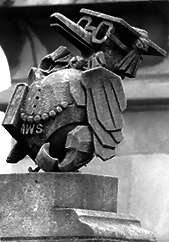The past few months at my internship here in the IU Archives I have been given quite a few reference questions to research for patrons. Two of these questions were from elementary school students in Indiana looking for information about IU for class projects. We’re quite flattered to receive letters from students and even more prepared to help (so if any readers have any questions about IU that you’ve always wanted answered, drop us a line!). One girl was doing a report on March Madness and specifically wanted information on the history of IU’s basketball program (about which we have a large folder of reference information, not surprisingly). The other query concerned a student who wanted to know more about IU’s history for his class report. These questions are easily answered with the use of our many reference files, located in the reading room. These files are great for a quick research question or just for finding out more about IU in a topical manner.
The wonderful part about being an archivist (or a lowly archival intern) is that archivists typically learn random facts about random things throughout the day, especially when working on research questions. For example, I always knew IU’s basketball program had a gloried history (since I grew up in Indiana) but I’d never thought to look more into it. After pulling out two or three packed reference files on the subject, however, it was clear that there is a lot to the story. I never realized that IU’s basketball program has produced so many NBA players – and has for decades – or that we have so many NCAA titles. (Granted, to most fans these realizations will seem obvious.) There are also photos of games throughout the century, and an article describing the first basketball game. I had some trouble narrowing down the folders to a few articles to xerox and mail to the student for her project. There was so much information in the folders.
Additionally, when I looked up basic histories of IU, I found a lot of neat facts that aren’t quite well-known anymore. As a graduate student who lives in Wells Library, I never would have known that there’s a statue of a duck in graduation garb above the west entrance of Goodbody Hall without answering this reference question. Last week I took a walk around campus when the weather was nice and I was able to find the duck-professor. Knowing tiny details about things like this makes me feel closer to this school. A general history of the campus is also online in multiple locations – the archives have a timeline on our web page, which is a great overview of the university’s past. The internet is a good place to find information about the college, but the best place is the archives and the reference files in the reading room. You can learn a lot more than what you came in to find out.
Not all archives have these kind of reference files available to patrons, and arguably an archivist’s time is better spent processing collections and creating finding aids instead of updating reference files. However, files like these provide a wealth of information. Answering archival reference questions can tell you all kinds of things that you otherwise would never have thought to look up. Reference can be a learning experience for both the patron and archivist.

Leave a Reply